Overview Of Fishing Little River
The East Prong of Little River is generally just referred to as “Little River” by locals. This is a large stream by Great Smoky Mountains National Park standards. The stream begins high on the flanks of Clingmans Dome and Mount Collins. It quickly becomes a larger stream with the addition of Rough Creek and especially Fish Camp Prong. Here, Little River becomes a truly large stream compared to other Park streams. Fishing Little River is a treat and this stream is a must fish for any visiting angler.
For the next four miles downstream, the river is never far from its namesake trail. At Elkmont, another tributary, Jakes Creek, enters from the west. Little River continues north for another mile or so, now followed by a road, until it reaches Little River Road. Here it turns sharply west on its run to Townsend. Just above the Park’s boundary outside of Townsend, Middle Prong joins and the river becomes even larger. The pools dominate and the river begins to lose its mountain characteristics. Pocket water gives way to classic riffle/run/pool stream structure as it winds lazily through Townsend, the home of Little River Outfitters.
Leaving town, the river continues its journey to the lowlands by speeding up again as it descends through the foothills near Walland. Trout are stocked from Walland upstream when water temperatures allow. Fishing Little River below Townsend is primarily a warm water proposition. Long lazy pools are perfect for exploring in a canoe or kayak. The smallmouth bass and panfish will keep you occupied for hours on this section. Eventually, Little River enters Fort Loudon Lake and the Tennessee River around 60 miles from its headwaters below Clingmans Dome.
The Lower Reaches: Townsend to the Sinks
Wild trout are abundant throughout the entire reach of Little River within the Great Smoky Mountains National Park. The lowest reaches experience large population fluctuations due to high summertime water temperatures. The results of severe drought back in 2007 and 2008 are still affecting this portion of the river. Drought again in 2016 has caused some additional natural population fluctuation. Large numbers of fish died in 2007 and 2008 when historically low flows combined with high summertime temperatures during the drought. Fish numbers are slowly improving down low, and if stream flows and water temperatures don’t become too severe again, this section will continue to come back.
Driving into the Park from Townsend, you will soon reach a split in the road. This is known as the Wye and is where Middle Prong enters from the west. Turn east (left) and you are now on Little River Road. Trout can be found in this section, but if you are interested in numbers, journey further upstream. Fishing Little River from here upstream will yield wild rainbow and brown trout along with the occasional stocked rainbow that swims up from Townsend. Smallmouth bass are also possible in the lowest reaches. Overall fish numbers are less as compared to water upstream. As a result, it sometimes helps to spend more time walking and locate fish visually first in this section.
Upstream from the Wye is the famed Little River Gorge. This is a very rugged section of river with huge pools and dangerous rapids. Kayakers find this section to their liking. Trout, while fewer in number, can reach impressive sizes in this big water. Unfortunately this is one of the sections that suffered from the drought years of 2007 and 2008. Barring future severe drought years combined with high water temperatures, this section should once again provide some fantastic fishing as trout slowly repopulate. The Gorge is a favorite during the golden stonefly hatches in late spring and early summer. However, due to its rugged nature, currently low fish numbers, and the difficulty in fishing here, I recommend continuing upstream before fishing Little River.
As you drive upstream, at between four and a half and five miles, you will see a large pullout on the right overlooking the stream. Across from this pullout is Meigs Falls. Meigs Creek is the first significant tributary above the Wye from an angler’s perspective. In other words it holds trout while other tributaries are tiny enough to not be worth your time.
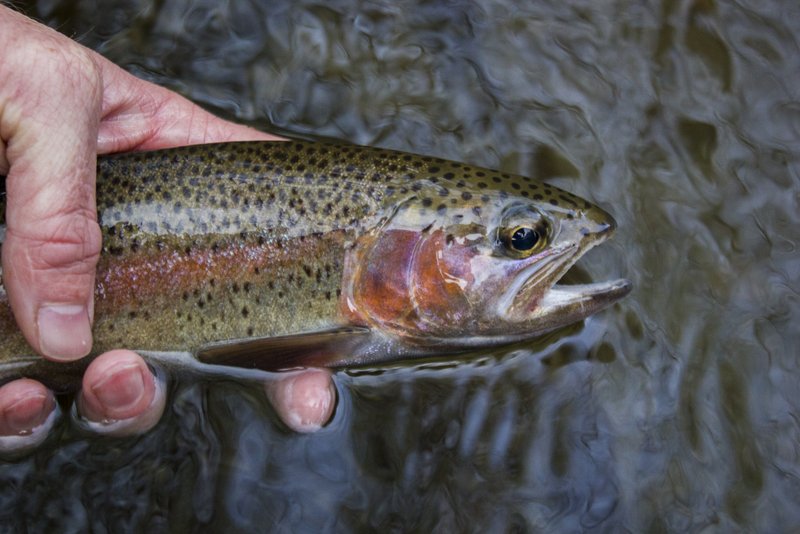
“Lower Little River Rainbow” © 2015 David Knapp Photography
The river is still rough here and becomes even more so as you continue on towards the Sinks which are close to six miles from the Wye. The stretch from Meigs Falls to the Sinks sees some good hatches and the number of wild trout starts to increase. Smallmouth can still occasionally be caught as high as the Sinks, but trout are the only gamefish found above this point. Access is very difficult to dangerous below the Sinks and should not be attempted when the water is high.
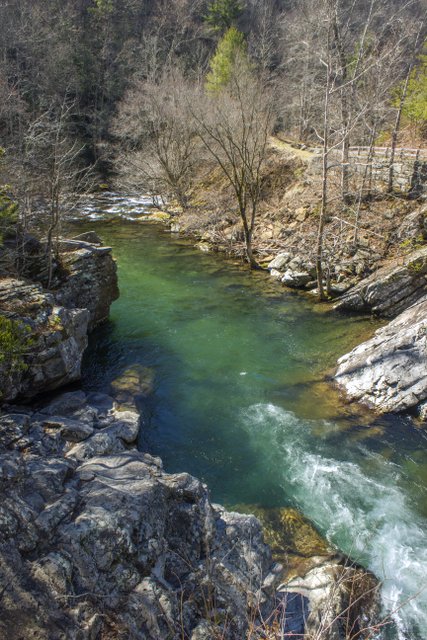
“Looking Downstream at the Sinks” © 2014 David Knapp Photography
At the Sinks is a large plunge pool. The drop into the pool is very popular with kayakers when the water is high and with swimmers in the warmer months. This pool is quite dangerous and unfortunately sees someone drown every few years. Please respect the power of the stream and do not push your limitations when trying to access good fishing water.
The Middle Reaches: Sinks to Elkmont
Continuing on upstream from the Sinks, you finally begin passing increasingly good trout water. The number of wild trout in this stretch gets better by the mile. By the time you reach Metcalf Bottoms Picnic area at around eight miles above the Wye, Little River is a great trout stream. At Metcalf Bottoms, the hills recede from the banks of the stream and the National Park Service maintains a highly popular picnic area. In the summer, fishing Little River here can be frustrating because of all the people wading and playing in the creek. However, some of the larger brown trout can be found in the outstanding pools here. This section is also a good one for the dry fly angler. The long flat pools sometimes boil with trout during the heaviest hatches.
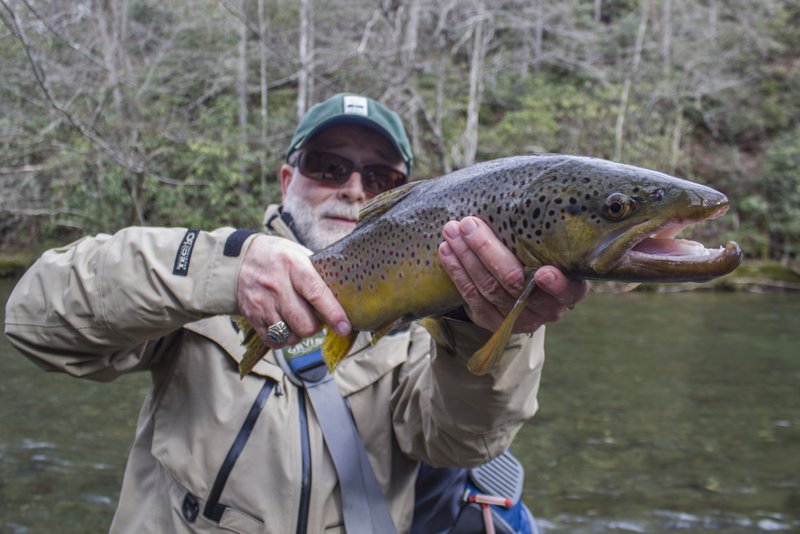
“Guide Trip Trophy Brown Trout” © 2015 David Knapp Photography
From Metcalf Bottoms upstream, the road continues to follow Little River. The next easily identifiable landmark is the Long Arm Bridge where the road crosses Little River. Shortly above this bridge is a very large pullout on the right side of the road next to the river around 11 miles above the Wye. If you follow the little path down to the water here and look upstream, you will see where Mannis Branch enters the river in a lovely falls. Fishing Little River is good throughout this entire section.
This whole stretch, from Metcalf Bottoms upstream, goes through several character changes as the river flows over and through various bedrock layers. Long pools and swift choppy pocket water alternate but the pocket water increasingly dominates. The water from Metcalf Bottoms to Elkmont contains both high numbers of trout as well as some very large specimens. Brown trout over 20 inches are present but rarely caught. These large fish are extremely wary and largely nocturnal. The Great Smoky Mountains National Park does not allow fishing at night so we are left to dream of what could be.
Above Mannis Branch, Millsap Bottoms is the only other place before the turnoff to Elkmont where you can park off of the road. There is room enough for probably seven or eight cars at this little pullout around 12 miles or a little more from the Wye. Just upstream is the turnoff for Elkmont, one of the better campgrounds for visiting anglers in the Park. Of course, numerous small pullouts right on the road are available as well along the entire river.
Approximately 14 miles from the Wye, Little River flows right through the middle of Elkmont Campground. Campsites right on the water are available. They cost an extra $3 a night during peak season which is well worth it I might add. Here, as at Metcalf Bottoms, the river valley spreads out a little with a large flat area along each side of the river. This section of river contains both good numbers of trout as well as good numbers of people playing in the water. Save this section for early mornings and late in the evening except in the cooler months.
Another stream of interest to fly anglers, Jakes Creek enters Little River near the upper end of Elkmont Campground. Learn more about Jakes Creek at the Minor Little River Tributaries page.
The Upper Reaches: Backcountry Above Elkmont
Anglers willing to get away from the roads will generally experience better fishing. The Little River above Elkmont follows this rule for the most part but not necessarily as dramatically as other streams in the Smokies. Day hiking anglers from Elkmont can often be found fishing Little River for the first two or three miles. Still, the fish usually seem to be a little more willing to eat and are less discerning when it comes to strange food items, also known as our flies. This section features all of the hatches and quality of fishing as the lower reaches below Elkmont. The nature of the stream changes above Elkmont though, and there are not as many large brown trout.
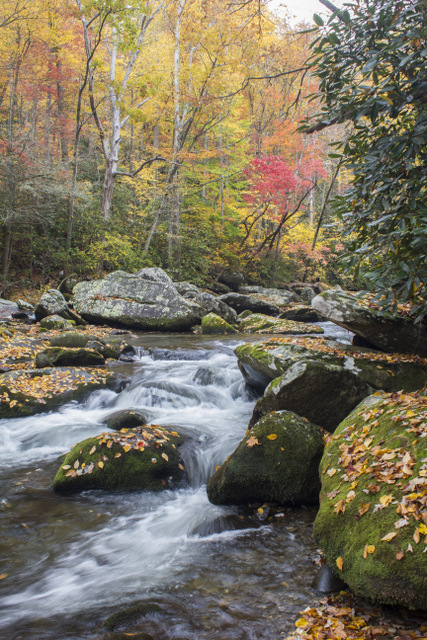
“Fall in the Little River Backcountry” © 2015 David Knapp Photography
Large pools are much fewer although not nonexistent. In between the pools, long stretches of pocket water and deep runs often provide cover for a trout behind nearly every rock. I’m always amazed at how small of a pocket it takes for a trout to move in and call it home. Anglers in this stretch can leave the hero casts at home except on a few select pools. Short line masters of high sticking will do well here, on good days catching well over 50 trout. I recommend a nine foot fly rod on this stretch. I’m partial to four and five weight rods because of the amount of weight I sometimes fish with my nymphs. I also like having the option of throwing streamers. That said, if you prefer a three weight you’ll probably catch just as many trout.
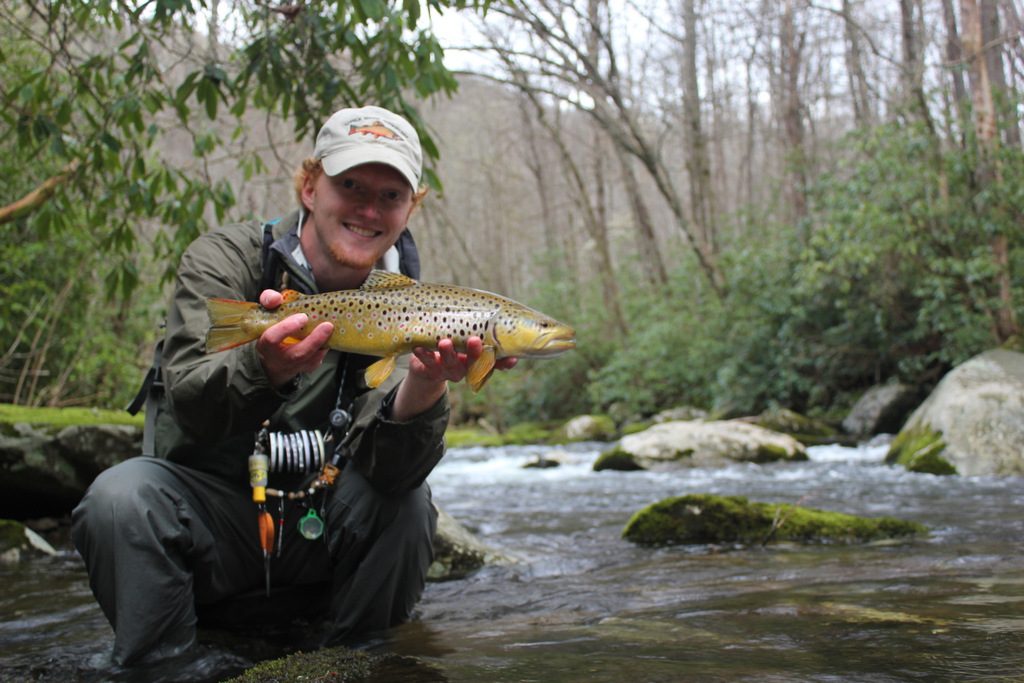
“Little River Backcountry Trophy Brown Trout” © 2014 David Knapp Photography
From Elkmont upstream, Little River is on the left side of the trail for about the first three miles. If you choose to enter the river to fish upstream, be sure you know where you can get back out again. While the trail follows the river, it does not always do so closely. Long stretches of rough pocket water away from the trail pose a danger if you happen to fall and injure yourself. Slick rocks, bees, yellow jackets, and snakes are a potential danger anywhere you fish in the Smokies. Accordingly I recommend taking appropriate precautions. This is especially true when fishing in the backcountry and help is farther away.
Around three miles upstream from Elkmont, the trail crosses Little River. This bridge is a great place to stop and take a water or lunch break. You can often spot trout from atop the bridge and even occasionally catch fish here. I’ve caught both rainbow and brook trout from this bridge although the brook trout are still rare at this elevation. The lowest that I’ve caught brook trout is approximately a half mile below this bridge, but again that is a rarity. Fishing Little River upstream from this bridge, you have another mile to go before you hit the Goshen Prong Trail.
This trail is the access to Fish Camp and Goshen Prongs and crosses Little River just above the junction with Fish Camp Prong. Little River is now a significantly smaller stream. Rainbows dominate in numbers here, but brown trout still hold on for another mile or two. Brook trout start to mix in once you get above backcountry campsite #24 (Rough Creek). You are now roughly four and a half miles from Elkmont. This backcountry campsite is quite popular and you can expect company, both human and otherwise. Often shut down because of bear problems, I recommend taking bear spray if visiting this site overnight. I’ve had a tent destroyed by a bear here due to no fault of my own I might add.
Brook trout numbers increase noticeably as the river starts to finally climb steeply at between five and six miles from the trailhead. Backcountry site #30 (Three Forks) on far upper Little River is off the beaten path and is also the end of the trail. Enterprising anglers fishing Little River here have to bushwhack upstream from this point to continue fishing. This is the backcountry Smokies where your only companions will likely be the stars at night and perhaps a stray bear.
Need a guide for fishing Little River? Learn more here on guided fly fishing trips with David Knapp of Trout Zone Anglers.
